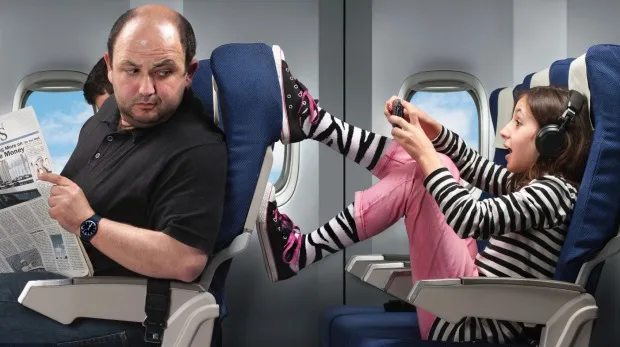
One, two, three - kick: Top behavior that annoys us in the air
Jan 22, 2017

Air travel can be a stressful experience, and certain behaviors can amplify that tension. One major annoyance is excessive loud talking, which disrupts the peace and makes it hard for fellow passengers to relax. Another common irritation is the inconsiderate use of reclining seats, often resulting in discomfort for those behind. Additionally, passengers who disregard personal space by spreading their belongings across multiple seats can create unnecessary friction. These behaviors contribute to an already challenging environment, making it essential for travelers to be mindful of their actions to ensure a more pleasant journey for everyone on board.
When it comes to air travel, the experience can often be marred by the behavior of fellow passengers. Understanding what annoys us in the air can help create a more pleasant flying experience for everyone. In this article, we explore the top behaviors that irritate us during flights, categorized into three main areas: personal space violations, noise disturbances, and travel etiquette. Let’s break these down in detail.
1. Personal Space Violations
One of the most common grievances among passengers is the invasion of personal space. Airplane seating is cramped, and many travelers are already uncomfortable. Here are some specific behaviors that can annoy fellow flyers:
| Behavior | Description | Impact on Others |
|---|---|---|
| Reclining Seats | Reclining your seat without warning can be bothersome when it encroaches on the space of the person behind you. | Can lead to discomfort and frustration for the passenger behind. |
| Encroaching Armrests | Taking up more than your fair share of the armrest can lead to tension between seatmates. | Creates an uncomfortable environment and can lead to awkward interactions. |
| Excessive Movement | Constantly getting up and shifting around can disrupt other passengers. | Can lead to interruptions and make it hard for others to relax. |
Being mindful of personal space is crucial for maintaining harmony in the cabin. Simple gestures, like asking if it’s okay to recline your seat, can go a long way in promoting a more respectful atmosphere.
2. Noise Disturbances
Airplanes are often viewed as a sanctuary of quiet, but that peace can be shattered by various noise disturbances. Here are the top culprits:
| Behavior | Description | Impact on Others |
|---|---|---|
| Loud Conversations | Engaging in loud conversations can disrupt the peace, making it hard for others to relax or sleep. | Can lead to annoyance and increased stress levels among passengers. |
| Unmuted Devices | Playing videos or music without headphones is a major irritant. | Can be distracting and disrespectful to those trying to enjoy their own space. |
| Children’s Noise | While children can be unpredictable, excessive crying or shouting can be especially challenging. | Can create tension and discomfort for nearby passengers. |
To minimize noise disturbances, consider using noise-canceling headphones and keeping conversations to a reasonable volume. Additionally, for parents traveling with children, bringing distractions can help manage noise levels.
3. Travel Etiquette
Lastly, general travel etiquette plays a significant role in how pleasant or unpleasant the flying experience can be. Below are some behaviors that can frustrate fellow travelers:
| Behavior | Description | Impact on Others |
|---|---|---|
| Cutting in Line | Boarding the plane out of turn or skipping the line is often perceived as rude. | Leads to frustration and feelings of unfairness among passengers. |
| Ignoring Carry-On Policies | Bringing oversized carry-ons can lead to delays and chaos during boarding. | Can create stress for both passengers and flight attendants. |
| Inattentive to Safety Briefings | Disregarding safety instructions can be dangerous and disrespectful to crew members. | Jeopardizes safety and can lead to misunderstandings in emergencies. |
Practicing good travel etiquette not only enhances your own experience but also contributes to a smoother journey for everyone on board. Being considerate of others and adhering to guidelines can significantly improve the flying experience.
Conclusion
Understanding the behaviors that annoy us in the air is essential for fostering a more enjoyable flying environment. Whether it’s respecting personal space, managing noise levels, or observing travel etiquette, every passenger has a role to play. By being mindful of our actions and considering how they affect others, we can all contribute to a more pleasant and respectful atmosphere in the skies. The next time you prepare for a flight, remember these tips to ensure a better experience for yourself and those around you.
By creating a more considerate and respectful environment, we can all look forward to the day when flying becomes an enjoyable experience once again.
Related Articles

Explore Thailand: The Best Islands to Visit for Paradise, Adventure, and Relaxation

The Ultimate Guide to the Best Islands in Thailand for Your Next Getaway

Do babies need passports? How to get a passport for a newborn

How to get a U.S. passport fast: here’s how to expedite the process

What is Mobile Passport Control: 5 reasons why you should use it

SENTRI vs. Global Entry: A detailed guide

Do you need a passport to go to the Bahamas? Let’s find out

Do you need a passport to go to Mexico? A detailed guide

Do you need a passport to go to Canada? We got the answer

Do You Need a Passport for a Cruise: An Essential Travel Guide

Booster Seat Requirements: All the Rules to Follow in Your Rental Car

What Are the World’s Most Powerful Passports, and How Does Yours Rank?

How to Take a Passport Photo at Home: A Helpful Guide

You've got to have heart! Southwest's new livery

Your opinion: Should water be free on low cost carriers?

Young women bolder than guys as solo travellers
